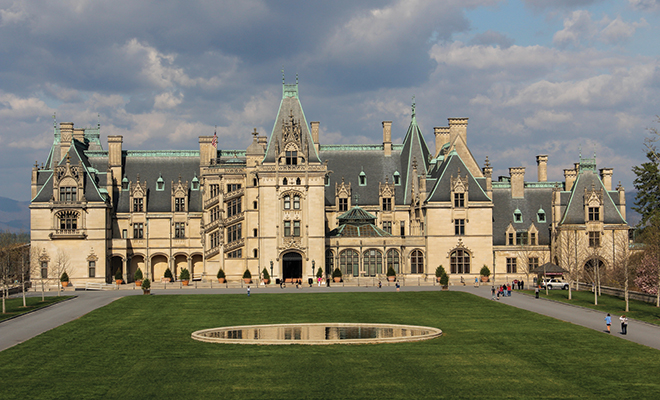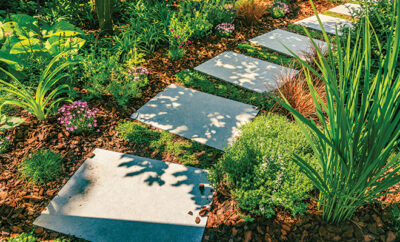
“Bilt” to be Sustainable: the Biltmore Estate
The Biltmore Estate, a historic home and grounds in Asheville, North Carolina, still has the ability to inspire awe in visitors. Biltmore House resembles a gigantic French chateau, complete with turrets, balconies and ornate gothic carvings.
Construction began in 1889 and was completed in 1895 on what is still America’s largest privately-owned estate. To offset some of the enormous expense of staffing and maintaining a house with 250 rooms and 178,926 square feet, owner George Vanderbilt II embraced sustainability as well as some of the latest technology of the time.
While Biltmore House was under construction, the estate was equipped with a woodworking shop, a brick factory and a railroad spur track for transporting building materials. Vanderbilt had the mansion wired for electricity and installed Edison light bulbs, both rarities in private residences at that time. Indoor plumbing and hot and cold running water were additional innovations. A central heating system was installed along with an electric elevator that’s still in operation.
The ornate design of Biltmore House belies the fact that self-sufficiency was an important concept for Vanderbilt. He wanted Biltmore to be a working estate that produced all the food required by his family, their employees and guests. The grounds of the estate were designed by landscape architect Frederick Law Olmstead, co-designer of New York’s Central Park. Biltmore Nursery was established while the home was being constructed and provided revenue from plant sales.
In addition to decorative landscaping and gardens, Olmstead planned a large production garden and pastures for herds of cattle and sheep. The Biltmore Poultry Farm, located on the estate, became nationally known for the quality of its free-range chickens and eggs. The estate also boasted a horse barn, hog farm and dairy. Self-sustainability went beyond livestock and agriculture on the estate. Vanderbilt had a dynamo generator installed in the basement of Biltmore House to supply electricity. The heating system was based on a convection system that allowed heat to rise naturally through the house’s four stories.
The estate had more than 100,000 acres of forests in 1895. Olmstead hired a trained forester to implement a plan that would improve the existing woodland with reforestation while providing additional income through the sale of timber. This successful scheme was one of the first forest management plans in the nation. Later, a forestry school set up on the estate trained some of the nation’s earliest foresters. As a result of his work on the Biltmore Estate, forester Gifford Pinchot was named first chief of the U.S. Forest Service.
Vanderbilt wanted a village to be part of his estate, just like the working estates in Europe. His architects created Biltmore Village, which included rental cottages and shops as well as a church, school, doctor’s office and post office. The cottages, which were equipped with central heating and indoor plumbing, provided another source of income for the estate.
The Vanderbilt family still owns the Biltmore Estate. Over the decades since the death of George Vanderbilt in 1914, portions of the 125,000-acre estate were donated to the U.S. Forest Service and other portions were sold. The remaining estate covers 8,000 acres and is maintained by the Biltmore Company. The dairy was closed, but in its place Biltmore Winery was established. Today, it’s the country’s most visited winery.
To generate additional income for maintenance during the Great Depression, Biltmore Estate was opened to the public in 1930. It was closed during World War II and used to store paintings and other art treasures from the National Gallery in Maryland. The estate was named a National Historic Landmark in 1963. Since then, it has become a major tourist attraction and event venue that receives more than a million visitors annually.
Sustainability is still an important part of the estate management philosophy and new advances in agriculture and energy continue to play an important role. Plants grow year-round in a nutrient solution in the estate’s greenhouses thanks to hydroponic technology. Solar panels have been installed on 10 acres of pastureland and cover about 20 percent of the estate’s power needs. Since 2013, fields of canola have been harvested for seeds and processed into biodiesel fuel that’s used to power farming equipment and vehicles. Cattle, sheep and chickens raised on the estate and a 200-acre produce garden supply the estate’s restaurants. The estate’s horses are used for riding lessons and tours of the estate.
Recent construction has added Antler Hill Village near the Biltmore Winery. It includes a hotel, shops, restaurants, a village green and an exhibition hall. The Biltmore Estate is especially famous for its Christmas decorations and celebrations, which pay tribute to the grandeur of Biltmore House and its breathtaking grounds and to the vision of George Vanderbilt, its creator. ■
Sources: biltmore.com, unctv.org and scetv.org.







